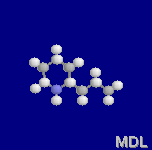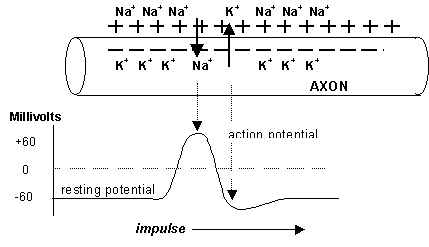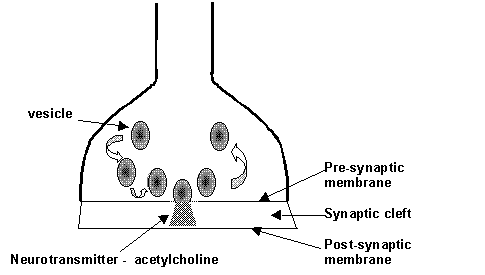
Coniine and the Hemlock Alkaloids
![]()
![]()
![]()
![]()
![]()
![]()
![]()
What are neurotoxins?
These are poisons, which include coniine, various other alkaloids, some snake and spider venoms and nerve gas, which disrupt the workings of the nervous system.
What is the nervous system?
This consists of billions of nerve cells or neurons [3]. Neurons are special elongated cells which can carry electrical impulses along their length. The nervous system is divided into two sections:
-
Central Nervous System (CNS)
which
consists of the brain and spinal cord. The CNS co-ordinates and
integrates information it receives and organises responses
-
Peripheral Nervous System
(PNS) which
consists of nerves running from the CNS to the peripheries - arms,
legs, abdomen, etc. The role of the PNS is to collect information
about changes in the environment registered by receptors
and pass this on to the CNS and to pass impulses from the CNS to the effectors,
for example skeletal muscles, which respond accordingly.
Neurons themselves fall into three classes:
-
Motor neurons
Sensory neurons
Intermediate neurons
Neurons can be very long, perhaps up to a metre in length and impulses travel along them from one end to the other at speeds of up to 100 m s-1 (over 220 m.p.h.!)
How does the Impulse pass along the neurone?
The long, cylindrical section of the neurone along which the impulse passes is known as the axon. This membrane of the axon does not conduct electricity and is normally impervious to the passage of ions such as Na+, and K+. However it is possible to force cations through this membrane by an energy absorbing "sodium pump". The system so arranges itself so that the majority of sodium ions reside outside the membrane and most of the potassium ions lie within the cell plasma. The numbers of sodium and potassium ions transferred is not equal and this results in an electrical potential of about 60 mV being set up across the membrane, the inside being negative and the outside being positive. This potential remains constant while the axon is at rest and so is referred to as the resting potential.
When an impulse passes down the axon the situation changes for an instant. As the impulse reaches a particular point on the axon the membrane becomes more permeable to sodium ions. The sodium ions, being in higher concentration on the outside of the membrane than in the plasma, rush into the interior of the cell and carry their charge with them. This suddenly reverses the potential and the interior becomes positive for an instant. This is known as the action potential. After this, the potassium ions rapidly migrate through the membrane to the outside, so reducing the positive charge within the cell and re-establishing the resting potential. The sodium and potassium pumps then re-establish the original concentrations of cations so that the process may be repeated. As the process occurs at one point in the axon, so it initiates a similar process at an adjacent site and so the impulse propagates along the axon in a wave like motion.

So what happens when the impulse reaches the end of the axon?
The point at which neurons meet is called a synapse. The end of an axon is a somewhat bulbous region known as a synaptic knob. The synaptic knob is full of mitochondria and small sac-like vesicles containing neurotransmitters such as acetylcholine and it is sealed by a membrane. There is a small gap approximately 20 nm wide, between this membrane and that of the next cell and this is known as the synaptic cleft. The membrane of the cell through which the impulse is being transmitted is called the pre-synaptic membrane while that of the cell to which the signal is to be transferred is called the post-synaptic membrane.

When the impulse reaches the synaptic knob it initiates an inflow of Ca2+ ions which causes the vesicles to move towards, and become attached to, the pre-synaptic membrane. The vesicles then discharge their neurotransmitter substance (acetylcholine) into the synaptic cleft. This material rapidly diffuses to the post-synaptic membrane where it initiates a process which generates an impulse in this cell. If the neurotransmitter remained bound to the site on the post-synaptic membrane it would maintain constant stimulation of the cell resulting in the repeated generations of impulses in the cell. The cell would become fatigued and cease to transmit pulses and so would become ineffective. To prevent this situation from occurring the acetylcholine receptor has an enzyme attached to it which rapidly decomposes the neurotransmitter once it has initiated a response. The enzyme acting on acetylcholine is called cholinesterase and it converts acetylcholine into ethanoic (acetic) acid and choline. The choline then diffuses back to the pre-synaptic membrane where it is reabsorbed and converted back into acetylcholine in the vesicles. If this enzyme ceased to act, not only would the post-synaptic cell become inactive due to constant stimulation resulting in fatigue, but the store of acetylcholine in the pre-synaptic cell would rapidly become exhausted and this cell too would become inactive.
…And so to neurotoxins
The chemical nature of synaptic transfer makes them very susceptible to disruption by toxins. Many alkaloid poisons, snake and spider venoms and nerve gases act in this way [4], [5].
Atropine acts by preventing acetylcholine from depolarising the post-synaptic membrane and so prevents generation of the impulse in this cell. Curare has a similar effect but acts at the junction between nerve cells and muscles.
a-Bungarotoxin, from the venom of snakes of the genus Bungarus operate in a similar fashion to curare. Nicotine and the coniine alkaloids (hemlock) have the reverse effect. These substances are agonists and activates nicotinic class of ACh receptors, locks the channel open. Eserine prevents cholinesterase from catalysing the hydrolysis of acetylcholine, thus stimulating the post-synaptic cell to generate a constant series of impulses until it is fatigued. Strychnine enhances synaptic transmissions to such an extent that the slightest stimulation will cause convulsive contractions in the victim's muscles. Some nerve gases used for military purposes act in the same way. a-Latrotoxin, a protein produced by the black widow spider induces massive acetylcholine release while Botulinus Toxin, consisting or a mixture of eight proteins produced by Clostridium botulinum, inhibits the release of acetylcholine at the neuromuscular junction.